Most brainstorming sessions fail because they lack clear structure, allowing dominant voices to overshadow quieter participants and leading to groupthink. When the environment isn’t inclusive or well-organized, ideas become limited and creativity stalls. Using facilitation tricks like structured turn-taking, visual aids, and actively managing participation can transform your sessions into more innovative, balanced, and productive discussions. If you want to discover effective strategies to boost your brainstorming success, keep exploring these proven techniques.
Key Takeaways
- Lack of clear goals and organization hampers idea flow and leads to confusion.
- Dominant participants overshadow quieter voices, reducing idea diversity and inclusivity.
- Groupthink and social conformity suppress dissent and unconventional ideas.
- Absence of visual aids and structured techniques diminishes creativity and engagement.
- Failure to manage group dynamics results in stagnation and missed innovative opportunities.
The Common Pitfalls That Undermine Brainstorming Effectiveness
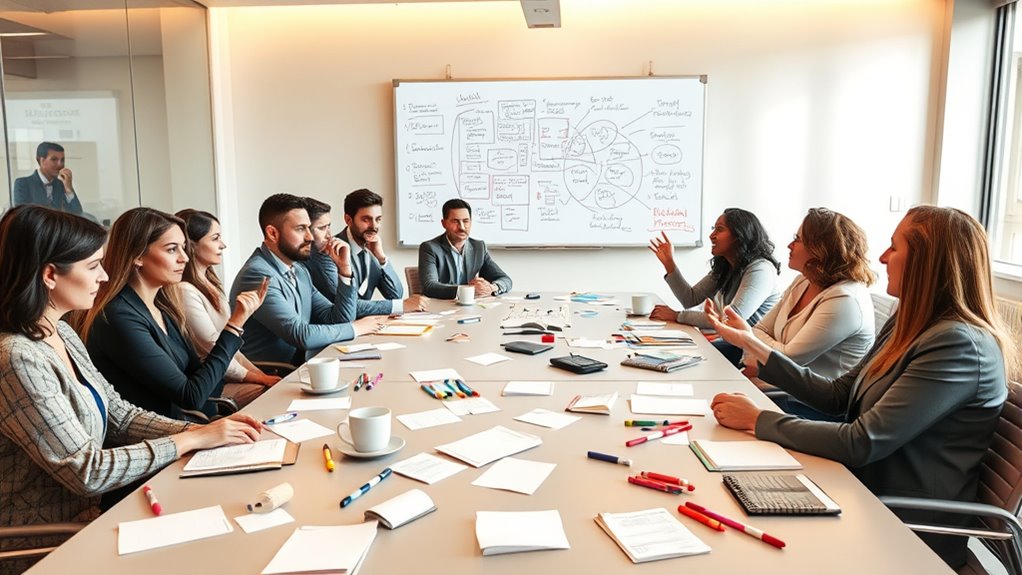
One of the biggest obstacles to productive brainstorming sessions is when participants feel hesitant to share ideas, often due to fear of criticism or judgment. This environment can lead to groupthink pitfalls, where individuals hold back to conform or avoid disagreement. Dominance issues also emerge when a few outspoken members overshadow quieter participants, stifling diverse input. These dynamics discourage creative risk-taking and limit the range of ideas generated. When people fear negative reactions or feel their contributions aren’t valued, they withdraw, reducing the session’s effectiveness. Recognizing these pitfalls is vital to fostering an open, balanced environment. Addressing dominance issues and promoting equal participation helps guarantee all voices are heard, driving more innovative and fruitful brainstorming outcomes. Understanding group dynamics can further help facilitators design sessions that maximize creativity and inclusivity.
How Group Dynamics Can Stifle Creative Input

When a few dominant personalities take over, they can shut down others’ ideas before they even get a chance. Groupthink also pushes members to conform, stifling fresh perspectives. Recognizing these dynamics helps you create a space where everyone feels comfortable sharing. Incorporating inclusive facilitation techniques encourages diverse viewpoints and mitigates the influence of dominant voices.
Dominant Personalities Suppress Ideas
Dominant personalities in a brainstorming session can unintentionally silence others, making it difficult for fresh ideas to surface. When someone asserts excessive dominance, it often leads to personality clashes, where quieter team members hold back their thoughts. This dominance suppression stifles creativity, as ideas are overshadowed by more assertive voices. You might notice that some team members stop contributing, fearing criticism or dismissal. To prevent this, facilitators need to recognize signs of dominance suppression early. Encouraging balanced participation helps ensure all perspectives are heard. Setting clear ground rules, like equal speaking time, can reduce personality clashes and create space for quieter voices. Understanding group dynamics and how they influence participation can help facilitators implement effective strategies to foster inclusive idea generation. When you manage these dynamics effectively, you foster an environment where innovation thrives without dominance overshadowing valuable input.
Groupthink Limits Innovation
Have you ever noticed how groupthink can quietly sabotage your team’s creativity? When social conformity takes over, team members may hesitate to voice unconventional ideas, fearing rejection or criticism. This behavior stems from cognitive bias, where individuals prioritize harmony over honesty, suppressing dissenting opinions. As a result, innovative solutions get stifled, and the group settles for familiar, safe ideas. The pressure to conform creates an environment where originality is sacrificed for consensus. To combat this, you need to encourage diverse perspectives and foster an open atmosphere. Challenge assumptions, ask for alternative viewpoints, and guarantee everyone feels safe sharing ideas without judgment. Breaking free from groupthink opens up genuine innovation and helps your team generate fresh, impactful solutions. Developing a culture of self-awareness can further empower team members to express their unique ideas confidently.
The Impact of Poorly Structured Sessions on Idea Generation
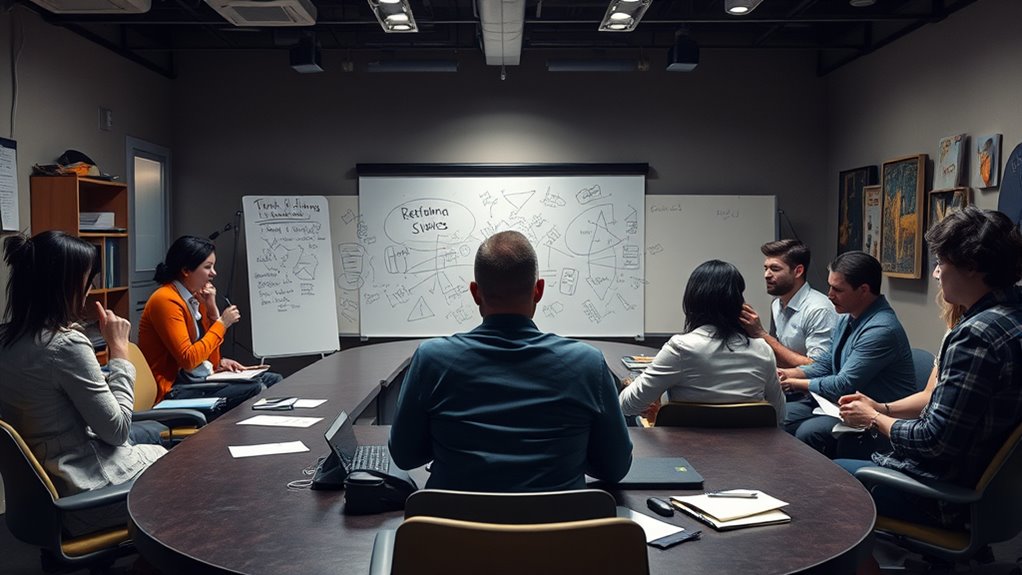
Poorly structured brainstorming sessions can severely hinder the flow of ideas and limit creativity. When the process lacks clear goals or organization, your creative confidence takes a hit, making it harder to share bold or unconventional ideas. Without a structured approach, idea diversity shrinks because participants may feel uncertain or hesitant to contribute outside the norm. This stifles innovation and creates an environment where only safe, familiar suggestions surface. As a result, you miss out on fresh perspectives that could lead to breakthrough solutions. A disorganized session also discourages spontaneous thinking, reducing the overall richness of ideas. To foster better idea generation, structure is essential—guidelines, prompts, and clear roles help *access* your team’s full creative potential. Incorporating visual tools like the Design Thinking Venn Diagram can further clarify objectives and foster collaborative ideation.
Techniques to Foster Inclusivity and Equal Participation
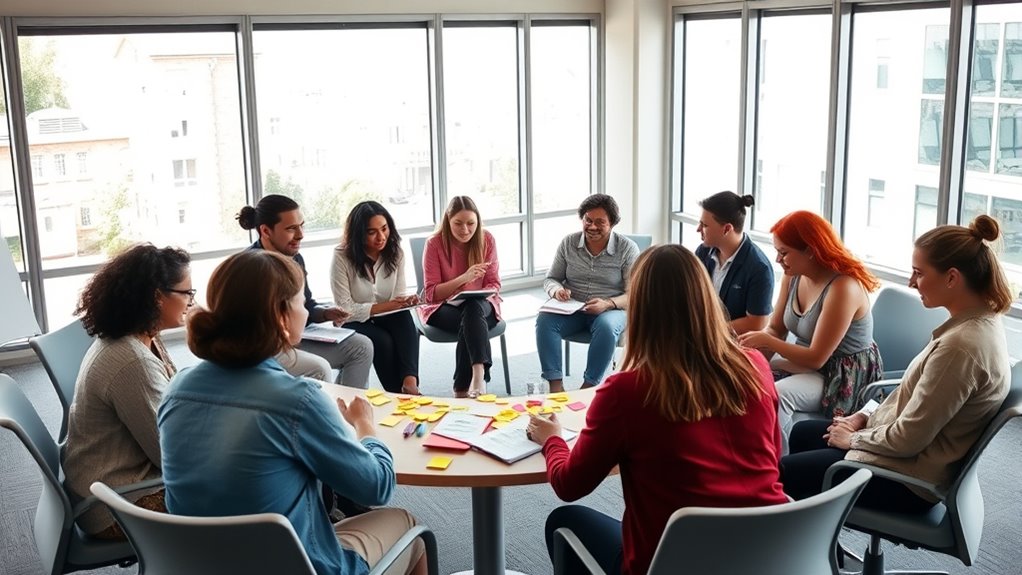
To guarantee all voices are heard during brainstorming sessions, adopting inclusive techniques is essential. An inclusive culture encourages diverse perspectives, making participants feel valued and comfortable sharing ideas. Start by setting ground rules that promote respect and openness, ensuring no one dominates the conversation. Use methods like round-robin, where everyone speaks in turn, or anonymous idea submissions to balance participation. Be mindful of group dynamics, actively inviting quieter members to contribute. Establishing a participation balance prevents dominant voices from overshadowing others. Incorporating essential oils for inclusivity such as lavender or peppermint can enhance the environment by promoting calmness and alertness, creating a more receptive atmosphere for idea sharing. By fostering an environment where every individual’s input is welcomed and equal, you create a space that sparks innovation and prevents the common pitfalls of exclusion. These strategies help build a more inclusive culture that drives richer, more diverse idea generation.
Using Visual Aids and Tools to Enhance Creativity
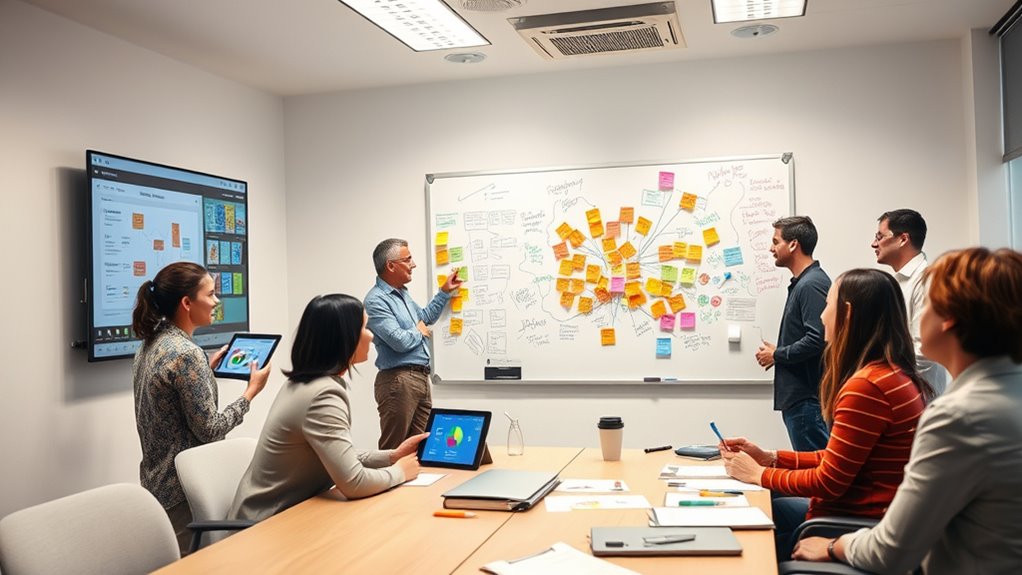
Visual aids and tools can considerably boost creativity during brainstorming sessions by making abstract ideas more concrete and easier to explore. Using visual aids like charts, mind maps, and diagrams helps you and your team visualize connections and patterns that might otherwise go unnoticed. Creative tools such as sticky notes, whiteboards, and digital platforms enable rapid idea generation and organization, fostering a more dynamic environment. These aids stimulate different thinking styles, making it easier for participants to contribute and build on each other’s ideas. Incorporating visual elements keeps energy high and prevents discussion from stagnating. Ultimately, effective use of visual aids and creative tools transforms a flat discussion into an engaging, productive session that sparks innovative solutions. Additionally, leveraging visual communication techniques can help clarify complex concepts and ensure everyone stays aligned throughout the process.
Strategies for Managing Dominant Voices and Encouraging Quiet Contributors

To create a balanced brainstorming environment, you need to equalize participation and prevent dominant voices from overshadowing others. Implement structured turn-taking to give everyone a chance to share their ideas without interruption. By actively encouraging quiet contributors, you can unseal diverse perspectives that might otherwise go unheard. Additionally, understanding color accuracy and how it influences overall image quality can help facilitators recognize the importance of diverse viewpoints in visual problem-solving sessions.
Equalize Participation Dynamics
Managing participation in brainstorming sessions requires balancing voices so everyone feels heard. An equity bias can lead to participation imbalance, where dominant voices overshadow quieter contributors. To address this, actively invite input from those who seem less vocal, making space for their ideas without pressure. Use neutral prompts like, “What are your thoughts?” or “Would anyone like to add?” to encourage quieter team members. Be mindful of unconscious bias that favors outspoken participants and consciously create an inclusive environment. By monitoring speaking time and ensuring equal opportunity, you help prevent dominance by a few and give everyone a fair shot to contribute. Incorporating diverse perspectives enhances creative problem-solving and leads to more innovative outcomes. This approach fosters diverse ideas and cultivates a more balanced, productive brainstorming session.
Use Structured Turn-Taking
Implementing structured turn-taking can effectively balance participation in brainstorming sessions by ensuring everyone has a chance to speak. Turn taking strategies prevent dominant voices from monopolizing the conversation and encourage quieter participants to contribute. By establishing clear rules—such as going around the table or using a talking object—you create a fair environment where each person’s ideas are heard. This participation balance helps foster a more inclusive atmosphere, boosting creativity and collaboration. When everyone feels their input matters, engagement increases and groupthink diminishes. Use simple prompts like “Let’s hear from someone who hasn’t spoken yet” or set specific time limits. Structured turn-taking keeps the discussion organized, prevents interruptions, and guarantees all voices are valued equally. Incorporating voice modulation techniques can also improve clarity and ensure that every contribution is impactful.
Encourage Quiet Voices
Building on the idea of structured turn-taking, creating space for quiet voices guarantees that all participants contribute equally. Some team members prefer silent contributions or need extra encouragement to speak up. Use listening techniques like active listening and reflective questions to draw out these quieter voices. Encourage participants to jot down ideas silently before sharing, which helps reduce pressure and allows thoughtful input. Set aside specific moments for silent contributions, ensuring everyone has time to think without interruption. As a facilitator, be mindful of dominant voices and gently invite quieter members to share. This balanced approach fosters diverse perspectives, strengthens collaboration, and prevents the session from being dominated by a few loud voices.
Practical Facilitation Methods to Keep Sessions Focused and Productive
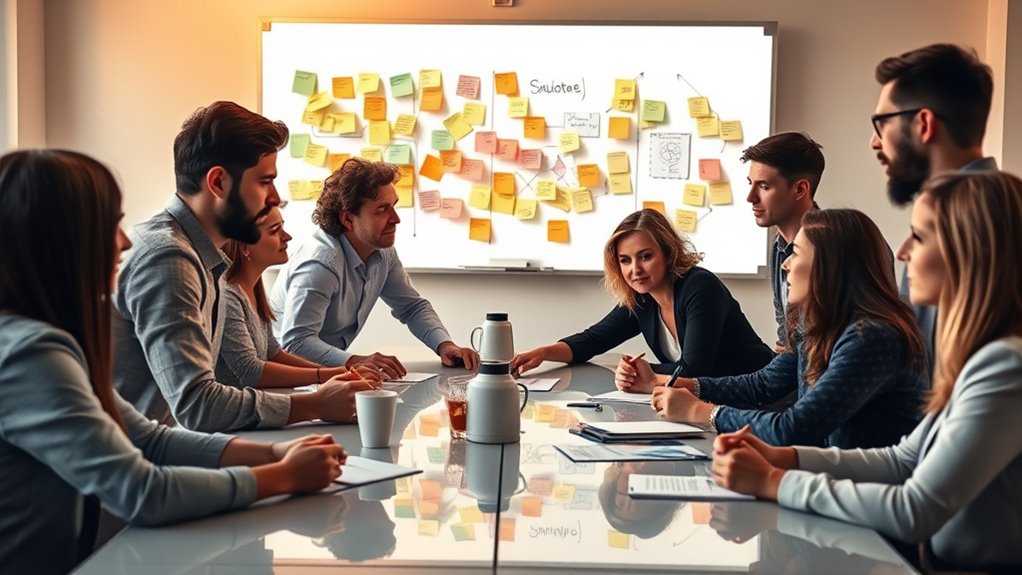
Keeping a brainstorming session focused and productive requires practical facilitation techniques that steer discussions without stifling creativity. One effective method is using mindfulness techniques to help participants stay present and attentive, reducing distractions and promoting clarity. Incorporate idea scaffolding by breaking complex concepts into manageable parts, guiding participants to build on each other’s suggestions systematically. This approach keeps the flow organized and prevents the conversation from veering off-topic. Set clear objectives at the start, and gently redirect tangents back to the main goal when needed. Encourage active listening and pause to reflect periodically. By combining mindfulness with structured idea scaffolding, you create a supportive environment that nurtures focus and encourages innovative thinking without sacrificing spontaneity.
Frequently Asked Questions
How Can I Measure the Success of a Brainstorming Session?
You can measure the success of a brainstorming session by evaluating idea evaluation and participant engagement. Track how many ideas are generated and how diverse they are, indicating effective idea evaluation. Also, observe participant engagement levels—note if everyone contributes and shares freely. High engagement and a rich variety of ideas suggest a successful session. Use feedback forms or follow-up discussions to gauge if the session met its goals and fostered collaboration.
What Are Common Signs of a Failing Brainstorming Session?
Imagine a room where ideas stagnate like a paused movie. You notice quiet voices overshadowed by dominant personalities, groupthink taking over, and creativity dwindling. These signs show your brainstorming session is failing. When dominance dynamics suppress diverse input or groupthink leads to conformity, innovation stalls. If the energy feels dull and participation uneven, it’s time to steer the session differently, encouraging quieter voices and fostering open, balanced dialogue.
How Do Cultural Differences Affect Brainstorming Effectiveness?
Cultural differences can considerably impact your brainstorming sessions by creating barriers in communication styles. You might find that some participants hesitate to share ideas openly due to cultural norms or language differences, which limits creativity. To improve effectiveness, you should encourage an inclusive environment, recognize diverse communication styles, and facilitate respectful dialogue. Addressing these cultural barriers helps guarantee all voices are heard, fostering richer, more innovative ideas during your sessions.
Can Virtual Brainstorming Sessions Be as Effective as In-Person Ones?
It’s understandable to wonder if virtual collaboration can match in-person creativity. With the right digital tools, you can foster engagement and idea sharing effectively. Virtual brainstorming sessions might lack some face-to-face energy, but they enable diverse participation and flexibility. By leveraging video, chat, and collaborative platforms, you can create an environment where ideas flow freely, making virtual sessions just as impactful as in-person ones.
What Role Does Prior Preparation Play in Successful Brainstorming?
Prior preparation is key to successful brainstorming. You should focus on aligning your mindset and clarifying your goals beforehand, which helps you stay focused and open-minded during the session. When you understand the purpose and have a clear direction, you’re more likely to contribute meaningful ideas and build on others’ suggestions. This preparation fosters a productive environment, ensuring everyone stays engaged and the session achieves its intended outcomes.
Conclusion
If you master these facilitation tricks, you’ll transform your brainstorming sessions into unstoppable idea-generating machines. No more dead ends, no more silence, and definitely no more dull, forgettable meetings. Imagine a room where every voice shines, creativity explodes like fireworks, and ideas flow faster than a lightning storm. With these strategies, you’ll turn ordinary sessions into legendary innovation hubs—so powerful, they’ll make brainstorming disasters look like ancient history.









